Tea Urns in Old Sheffield Plate
Samovars and tea urns are some of the most elegant and impressive
pieces made in Old Sheffield plate.
They were mostly made between 1765 and 1840. After that Old Sheffield
was replaced by electro-plating technique.
Samovars can be quite large in size (23 inches or 58 cm tall) and they
can be quite decorated (especially the later examples).
But let's start first with the story of Old Sheffield Plate.
In about 1743 a Sheffield cutler named Thomas Boulsover discovered,
probably by accident, that silver could be fused onto copper. He was
employed as a cutler and he was repairing the handle of a knife while he
accidentally overheated the silver and copper and found that at this
temperature the two metals adhered.
He tried to separate them but found that a definite affinity has taken
place. He realized the possible application of this discovery and that's
how Sheffield Plate was born.
Boulsover started to produce buttons in Sheffield plate because they
were far less expensive that their counterpart in silver. He found a
ready market for buttons and other small items but he was not able to
expand his business due to lack of funding and bad recommendations by
his sales agent. He left the business of Sheffield plate and he started
with the manufacturing of saws.
But other manufacturers quickly understood the potential of Sheffield
plate and they started their activity around 1762-1765.
The first of them was Josiah Hancock also from Sheffield, who started to
produce larger items like coffee pots and candlesticks. Hancock
introduced the single-lapped copper edge. A layer of silver, thicker
than formerly, was extended beyond the edge of the copper to overlap and
conceal the raw edge.
Another tecnique (1768-1810) was the double-lapped copper edge. Copper
wire was silver plated and then drawn in a fine thread that could be
flattened and soldered to the edge of the silvered plate.
Finally another tecnique was the silver lapped edge (1775-1815), which
was formed by a fine U-shaped wire of sterling silver fitted over the
edge of the plate, soldered on both surfaces and the joints burnished
until invisible.
From Sheffield the craft soon became established in Birmingham and then
in the rest of England. Great manufactures of Old Sheffield Plate
were Matthew Boulton, who created beautiful and elaborate pieces, Thomas
Bradbury, Samuel Roberts and Thomas Nicholson plus many others.
The instant popularity of Sheffield plate was truly amazing. At that
time, articles in silver could only be bought by aristocrats, the rest
of the people could only use articles in pewter or wood. But with
Sheffield plate, even the middle class could afford to buy items very
similar to silver. This revolution continued with electro-plating after
1840. The invention of electro-plating in 1838 killed the Old
Sheffield plate business even if some pieces were still made in
Old Sheffield for other 20 years by some companies.
It is possible to distinguish items in Old Sheffield from
electro-plate based on the following considerations:
a) Usually the color of the silver is whiter in appearance than Old
Sheffield, which has the same soft blue 'glow' of the old sterling
silver.
b) Engraving, which requires the removal of metal, does not
feature in Sheffield Plate (except for coats of arms)
c) Old Sheffied items are produced with much higher quality than
electro-plate items even if there are some exceptions: Elkington and
some American manufacturers (Pairpoint, Barbour, Reed & Barton) produced
beautiful electro-plate items.
d) a piece with 'Sheffield Plate' stamped on it is electroplate
made in Sheffield at the end of 19th century than the genuine Old
Sheffield plate.
e) Most pieces of Old Sheffield plate hollow ware
(candlesticks, coffee pot) have a visible seam.
f) Some articles like urns have a liner. Once this is removed, a
dull leadish color caused by tin, should be visible on the inside. A
silver color inside indicates replating.
g) Decoration is always flat chased. If a piece has the coat of
arms, it should be placed on a square or oval of sterling silver. With
the time, Old Sheffield and sterling silver get different colors.
Now, let's go back to the tea urns.
Tea urns are containers for hot water. They were initially made in
silver but we can see examples of Sheffield Plate as early as 1765. The
original ones were small with a capacity of 2-3 liters and were
beautiful specimens of fine proportions.
As the industry progressed, the size of urns grew until shortly before
termination to examples of gigantic proportion with beautiful
decoration. Below we can see the evolution of style from 1780 to
1820-1830.
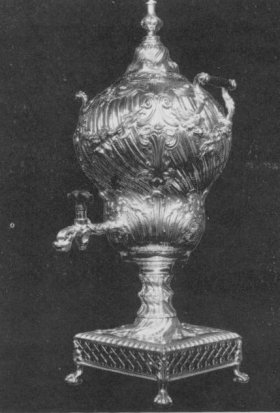 |
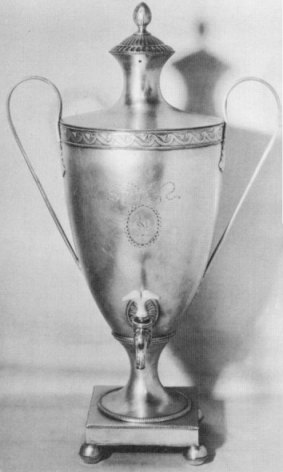 |
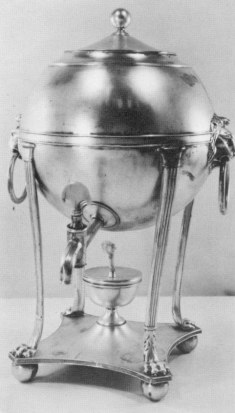 |
Tea urn made in 1770
|
Tea urn made in 1780
|
Tea urn made in 1800
|
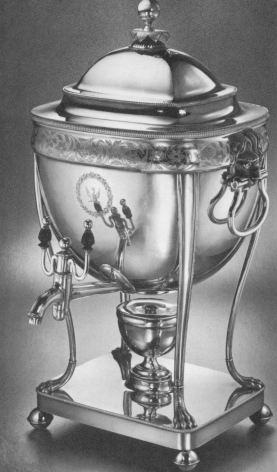 |
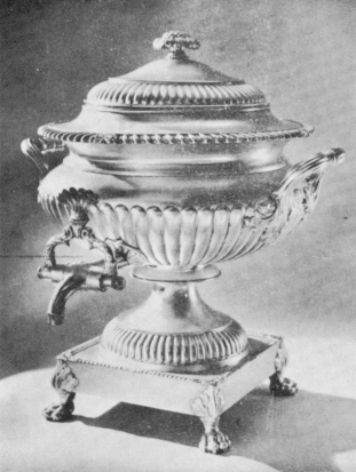 |
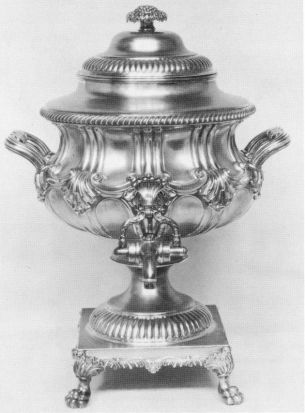 |
Tea urn made in 1810
|
Tea urn made in 1815
|
Tea urn made in 1825
|
The majority of tea urns were made with no apparatus for keeping the
contents hot. The idea was to heat a piece of iron and insert it in a
small container fitted to the inside of the urn. In later version the
tea urn was fitted with an internal cilinder for the charcoal. This is
also the solution adopted by the Russian samovars (an example is shown
in the picture below from the author's collection. The example is not
Old Sheffield plate but electro plate from the 1870).
With the introduction of a small alcohol lamp, which was placed
directly beneath the base of the body a really satisfactory solution was
reached. Unfortunately the solution was found around 1830-1840, at the
end of the age of Old Sheffield plate, so specimens of this type
are very rare and they can fetch very high prices today.
I have started to collect Old Sheffield tea urns and samovars
because I was impressed by the great quality of the work in items of
such large size. Even if they are not used anymore for their primary
function, their beauty can be still the center of attention in the
living room as it was 200 years ago.
Some Bibliography :
The Book of Sheffield Plate by Seymour B. Wyler - great book with
many pictures and hallmarks of silver manufacturers
History of Old Sheffield Plate by Bradbury - The first and most
complete book about Old Sheffied Plate
Old Silver and Old Sheffield Plate by Howard Pitcher Okie - very
complete with a lot of hallmarks of Old Sheffield Plate
manufacturers.
Note: consider that a lot of Old Sheffield plate is not marked, so
do not discard an old tea pot even if it does not have hallmarks !
Following are examples from my collection
Bought at an auction in Baltimore, USA. Made in 1780
Bought at an auction in North Carolina, USA. Made in 1825
Bought at an auction in Dublin, Ireland. It is Russian
electro-plate. Made in 1860-1880
Gianmarco Baldini - 2004 -
|